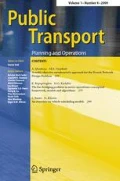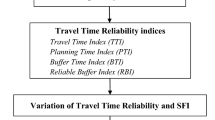Abstract
A travel time reliability-based approach is proposed to assess the effect of the light rail transit (LRT) system on the road network within its vicinity. A 4-mile stretch of the Blue Line LRT extension, which connects the Old Concord Road and the University of North Carolina at Charlotte (UNC Charlotte) main campus in Charlotte, North Carolina (NC), was considered as the study corridor. The raw travel time data was collected from the Regional Integrated Transportation Information System (RITIS) website at one-minute intervals. The average travel time (ATT), planning time (PT), buffer time (BT), buffer time index (BTI), and planning time index (PTI) were computed for each link, referred to as Traffic Message Channel (TMC) in this research, by day-of-the-week and time-of-the day. Further, the travel time reliability of the links on the LRT extension corridor and adjacent corridors (both the parallel route and the cross-streets) were computed for different scenarios: network without LRT, testing phase of LRT, first month of LRT operation, third month of LRT operation, sixth month of LRT operation, and ninth month of LRT operation. The travel time reliability of the alternate route and cross-streets was affected by the LRT system operation. Increased green times and better coordination on the LRT corridor and the benefits associated with the alternate mode/route choice for commuters may be the reason behind the steadiness in travel time performance measures due to the LRT. The methodology and findings help transportation planners and engineers in comparing the performance or efficiency of large-scale public transportation projects like LRT and bus rapid transit (BRT) on travel time reliability within its vicinity.










Similar content being viewed by others
References
Arrington GB, Cervero R (2008) Effects of TOD on housing, parking, and travel. TCRP Report 128, Transportation Research Board of the National Academies, Washington, DC
Bates M, Lee L (1982) At-grade or not at-grade: the early traffic question in light rail transit route planning. In light rail transit: new system successes at affordable prices. TRB Special Report 221, Transportation Research Board, National Research Council, Washington, DC
Chandler C, Hoel LA (2004) Effects of light rail transit on traffic congestion. Publication UVACTS-5-14-68. VA: Center for Transportation Studies, University of Virginia, Charlottesville
Charlotte Area Transit System website (2018) LYNX Blue Line, Charlotte. www.charlottenc.gov/cats/rail/lynx-blue-line/Pages/default.aspx. Accessed 27 Apr 2018
Chiabaut N, Barcet A (2019) Demonstration and evaluation of intermittent bus lane strategy. Public Transp. https://doi.org/10.1007/s12469-019-00210-3
Chiabaut N, Küng M, Menendez M, Leclercq L (2018) Perimeter control as an alternative to dedicated bus lanes: a case study. Transp Res Rec 2672(20):110–120
Clark RR (1984) General guidelines for the design of light rail transit facilities in Edmonton. Edmonton, Alberta, Canada. www.trolleycoalition.org. Accessed 26 Apr 2018
Eichler M, Daganzo CF (2006) Bus lanes with intermittent priority: strategy formulae and an evaluation. Transp Res B Methodol 40(9):731–744
Ewing R, Tian G, Spain A (2014) Effect of light-rail transit on traffic in a travel corridor. United States Department of Transportation, Washington
Federal Highway Administration (FHWA) (2005) Travel time reliability: making it there on time, all the time. www.ops.fhwa.dot.gov/publications/tt_reliability/TTR_Report.htm. Accessed 3 Oct 2019
Garrett TA (2004) Light rail transit in America: policy issues and prospects for economic development. Unpublished manuscript. Federal Reserve Bank of St. Louis, Research Department.
Harrison S (2019) Light-rail ridership is below projections. Why CATS says that’s OK. The charlotte observer [charlotte]. www.charlotteobserver.com/news/politics-government/article214184194.html. Accessed 3 Oct 2019
Islam MT, Tiwana J, Bhowmick A, Qiu TZ (2016) Design of LRT signal priority to improve arterial traffic mobility. J Transp Eng 142(9):04016034
Kattan L, de Barros AG, Saleemi H (2013) Travel behavior changes and responses to advanced traveler information in prolonged and large-scale network disruptions: a case study of west LRT line construction in the city of Calgary. Transp Res F Traffic Psychol Behav 21:90–102
Knowles RD (1992) Light rail transport. In: Whitelegg J (ed) Traffic congestion: is there a way out?. Leading Edge Press & Publishing Ltd., Hawes, pp 107–130
Knowles RD (1996) Transport impacts of Greater Manchester's metrolink light rail system. J Transp Geogr 4:1–14
Lane BW (2008) Significant characteristics of the urban rail renaissance in the United States: A discriminant analysis. Transp Res A Policy Pract 42(2):279–295
Litman T (2012) Rail Transit in America: a comprehensive evaluation of benefits. www.vtpi.org. Accessed 26 Apr 2018
Mackett RL, Edwards M (1998) The impact of new urban public transport systems: will the expectations be met? Transp Res A Policy Pract 32:231–245
McLeod DS, Elefteriadou L, Jin L (2012) Travel time reliability as a performance measure: applying Florida's predictive model to an entire freeway system. Inst Transp Eng ITE J 82(11):43–47
Portillo E (2019) A year after new light rail opened, can Charlotte afford $8 billion in future lines? The Charlotte Observer [Charlotte]. www.charlotteobserver.com/news/politics-government/article227603799.html. Accessed 3 Oct 2019
Pulugurtha SS, Penmetsa P, Duddu VR (2017) Monetizing reliability to evaluate the impact of transportation alternatives. North Carolina Department of Transportation, Raleigh
Schrank D, Eisele B, Lomax T, Bak J (2015) The 2015 urban mobility report. Texas Transportation Institute, Texas A&M University, Texas, College Station, TX
Venglar S, Fambro D, Walters C (1994) Development of analytical tools for evaluating operations of light rail at grade within an urban signal system. Final Report No. FHWA/TX-94/1278-4F, Texas Transportation Institute, College Station, Texas.
Wakabayashi H, Asaoka K, Iida Y, Kameda H (2003) Mode choice model with travel time reliability and commuters' travel behavior before/after a major public transportation service closure. In: Bell M, Iida Y (eds) The network reliability of transport. Emerald Group Publishing Limited, UK, pp 171–188
Acknowledgements
This paper is prepared based on information collected for a research project funded by the United States Department of Transportation—Office of the Assistant Secretary for Research and Technology (USDOT/OST-R) University Transportation Centers Program (Grant # 69A3551747127). The authors sincerely thank the staff of NCDOT, the Regional Integrated Transportation Information System (RITIS), and the city of Charlotte Department of Transportation (CDoT) for their help with data required for the study.
Disclaimer
This paper is disseminated in the interest of information exchange. The views, opinions, findings, and conclusions reflected in this paper are the responsibility of the authors only and do not represent the official policy or position of the USDOT/OST-R, or any other State, or the University of North Carolina at Charlotte or other entity. The authors are responsible for the facts and the accuracy of the data presented herein. This paper does not constitute a standard, specification, or regulation.
Author information
Authors and Affiliations
Corresponding author
Additional information
Publisher's Note
Springer Nature remains neutral with regard to jurisdictional claims in published maps and institutional affiliations.
Rights and permissions
About this article
Cite this article
Mathew, S., Pulugurtha, S.S. Assessing the effect of a light rail transit system on road traffic travel time reliability. Public Transp 12, 313–333 (2020). https://doi.org/10.1007/s12469-020-00234-0
Accepted:
Published:
Issue Date:
DOI: https://doi.org/10.1007/s12469-020-00234-0




